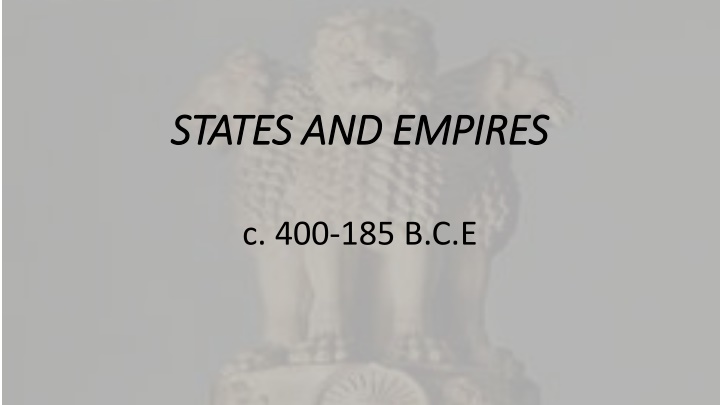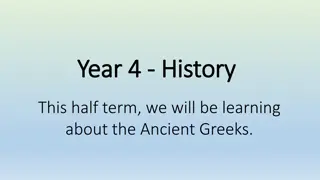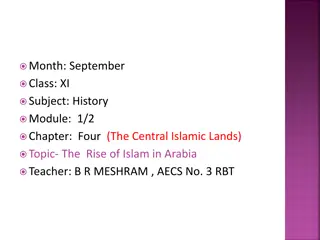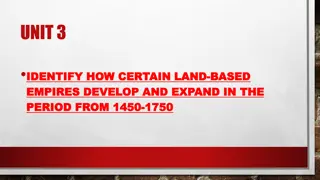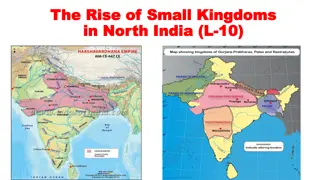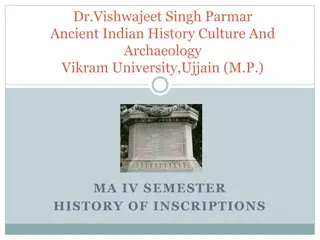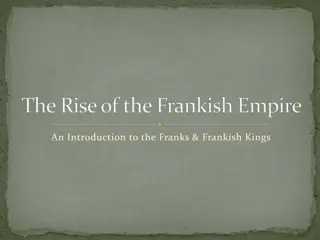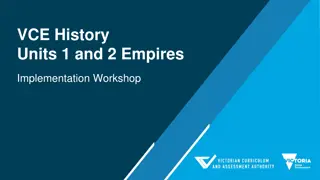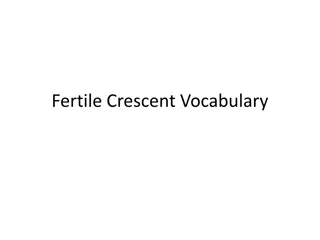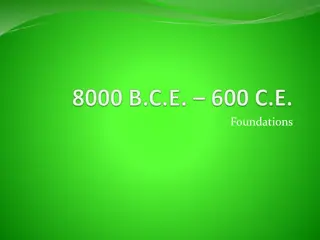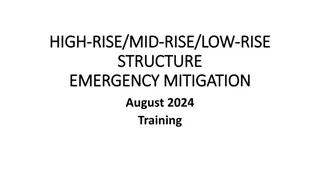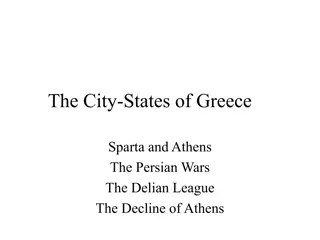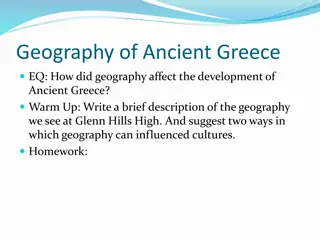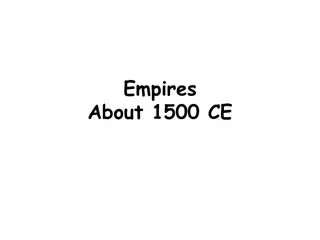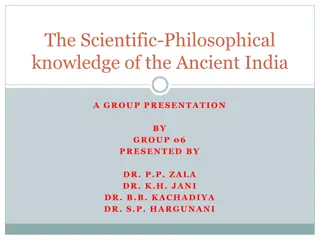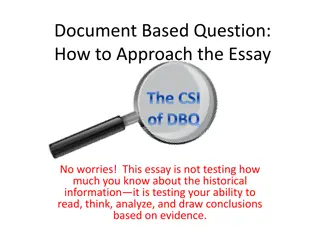Rise of States and Empires in Ancient India
Explore the emergence and consolidation of power under the Mauryan Dynasty in ancient India, focusing on key figures like Ashoka and significant historical developments such as the shift eastward in intellectual and political life. Discover the richness of sources detailing the period's political, economic, and social aspects, from Buddhist and Greek sources to the influential Arthashastra of Kautilya. Uncover the evolution of states and monarchies in the epic era, and the growth of commerce and urbanization shaping ancient Indian society.
Download Presentation

Please find below an Image/Link to download the presentation.
The content on the website is provided AS IS for your information and personal use only. It may not be sold, licensed, or shared on other websites without obtaining consent from the author.If you encounter any issues during the download, it is possible that the publisher has removed the file from their server.
You are allowed to download the files provided on this website for personal or commercial use, subject to the condition that they are used lawfully. All files are the property of their respective owners.
The content on the website is provided AS IS for your information and personal use only. It may not be sold, licensed, or shared on other websites without obtaining consent from the author.
E N D
Presentation Transcript
STATES AND EMPIRES STATES AND EMPIRES c. 400-185 B.C.E
Plan/Outline First, today, background to POLITICAL history The rise of Magadha (region) Emergence and consolidation of power under the Mauryan Dynasty Ashoka achievements and evaluation NEXT : Discuss Arthashastra AND Kumkum Roy s essay. Please have both read Then we have a review and exams!
4thC BCE: Center Moves further East EASTWARD SHIFT in the geography of intellectual and political life One reason we date the MBH before this period is because of this While mentioned, east still not that important for the writers of the MBH
From Paucity to Riches in terms of SOURCES 1. Buddhist sources, tell us about the Buddha but also about political and economic life 2. Greek sources, especially after Alexander the Great invaded India in 4th C BC, tell us lots about Mauryan court. We don t focus much on this, but textbook does 3. The famous Arthshastra of Kautalya, minister to the first Mauryan ruler, a remarkable treatise on Government and Administration. Read extracts for next class. 4. Information from inscriptions produced by Mauryan rulers like Ashoka 5. Jataka Stories . Short tales collected from Buddhist and other sources give window into the social life of the period
Historical Background and Developments By end of Epic era, STATES and MONARCHIES are quite prevalent By ca. 600 BCE there were 16 major states, (MAHAJANAPADA) who fought wars for territory Two kinds of States, MONARCHICAL and non-Monarchical, latter also called REPUBLICS (probably more like OLIGARCHIES) Difference a product of eastward movement: early pioneers did NOT (maybe could not) cross the major rivers Set up states on foothills of mountains, retained older forms of governance, SABHA and SAMITI. Also less surplus The ones who remained in the older heartland and later crossed rivers moved to MONARCHICAL forms of government (divine origins)
Growth in COMMERCE and Urbanization The period of emergence of states and empires, also, not coincidentally, reveals growth in commerce The finding of PUNCH MARKED COINS show that money was in circulation, so well beyond a barter economy Money = trade, so also growth of COMMERCE, some people in commerce, full time Evidence of artisans producing goods in large quantities, SRENIS, or guilds were important All of this contributes to what has been called the SECOND URBANIZATION of northern India (Rajgriha, Kashi [BENARAS], etc.) These sites associated with Northern Black Polished Ware
So Why War? Often take wars for granted. If there are two states, there will be war. But wars seldom for nothing Vedic texts say tribal lineages fought for cattle (= wealth), or for better pastures, or water Epics suggest expansion of settled agriculture, clearing of forests, annexation of land belonging to forest dwelling people Growth of settled agriculture produces surplus that allows for emergence of states and territorial kingdoms Kings covet others' capacity for producing of surplus: in most cases land, but also in some cases control over important trade routes Plus war gives a way of annexing accumulated surplus (royal treasure) that in turn help produce armies, weapons, and used to expand the base of surplus extraction (=> EMPIRE) So WAR = capture of accumulated SURPLUS, plus surplus yielding agricultural territory In the wars we study ultimately MAGADHA with capital at RAJAGRIHA most powerful, along with KOSALA, which had by then annexed KASHI, emerge as the major players
Overview: Political history of Rise of Magadha Keep in mind MAGADHA is a REGION ruled by different rulers and dynasties: 1. rise of Magadha around 500 BCE under BIMBISARA and his son AJATASHATRU 2. c.364 MAHAPADMA NANDA usurped throne 3. Alexander of Macedon (aka Alexander the Great) crossed the Indus c. 326 BCE. forced to turn back in 325 BCE. 4. Chandra Gupta MAURYA (CGM) came to power around 320 BCE Under CGM and son BINDUSARA the Mauryan (name of dynasty) empire expand, Karnataka to south, west to TAXILA. 5. CGM grandson ASHOKA the "beloved of the Gods" and arguably one of the most famous characters of Indian history 268-233 Ashoka = 1st all india empire
Questions about Rise of Magadha Will not repeat what textbook covers, e.g. dynastic changes. I will pay more attention to underlying changes. But that doesn t mean the political changes are unimportant, it means YOU cover those on your own! Two major questions: HOW? and WHY? HOW imagine empire: Persian influence? But they are to west OTOH, travel though difficult, not impossible. CGM accounts HOW: Magadhan state control a lot of iron ore, allow better cultivation, clearing forests, making plough-tips, and weapons. Make Magadha more powerful than other states
Magadha Expansion and Alexander BIMBISARA and son AJATSHATRU, first kings to make Magadha powerful. Bimbisara's dynasty ends 364 BCE 364 BCE MAHAPADMA NANDA usurped throne, created short-lived but important NANDA dynasty Under Nandas Magadha expand and subjugate most of north, central and eastern India Nandas in power when Alexander of Macedon reach the Indian subcontinent after vanquishing the great Persian empire A face off between Alexander s world-conquering armies and the formidable Nanda army (3000 elephants, 20,000 cavalry, 2000 four-horse chariots and over 200,000 infantry) was not to be Greek troops lost morale. Plus didn t like the weather. Alexander s armies crossed the Indus c. 326 BC. Fought and defeated a King called PORUS. But, after 8 years of incessant conquest Alexander forced to turn back in 325 BC
Magadha and the MAURYA dynasty In his travels in India, Alexander may have come across Chandragupta Maurya (CGM), but the only account of that is in a popular Sanskrit play written many centuries later Nor do we know exactly how CGM came to power around 320 BC Best account of CGM era is to be found in the ARTHASHASTRA, said to be written by his minister, Chanakya (aka Kautalya) that gives the author much of the credit for CGM success Chanakya, an arch-manipulator, anticipates the better-known Machiavelli by over a 1000 years! Arthashastra also a very important treatise on Government and Politics Tells us a lot about about Mauryan State, unmatched in its exposition of realpolitik Arthashatra also backed by reports of the Greek ambassador at Mauryan court
Arthashastra and the Mauryan Empire Arthashastra (more later) shows the Mauryas to run a centralized state, with control over public life and economy Spies, other informants play an important role Importance to the economy, rulers have to encourage trade, manufactures, and extension of cultivation But also military preparedness, and diplomacy to play off one enemy against other Under CGM and son BINDUSARA the Mauryan empire expands again as far south as Karnataka, and as far west as the TAXILA But it was CGM s grandson ASHOKA who became not only "beloved of the Gods" but one of the most famous characters of Indian history.
Ashoka Ashoka 268-233 Ashoka First all India empire: The watermark, the Lion Capital of Ashoka, found on top of one of his pillars, is also the official emblem of the Indian state today, akin to the American Eagle Devanam Piyadassi : Took historians a while to associate with CGM s grandson! How was Ashoka s empire governed? 1. The heartland around Magadha and neighboring Mahajanapads directly governed, a la ARTHASHASTRA. Rest divided into four provinces and these into districts, headed my MAHAMATRAS (not DHAMMAMAHAMATRAS, who had religious/ethical functions) 2 Kulke and Rothermund suggest the same, that given communications of the time, only some parts directly controlled, rest indirect If so then, particularly south of the Vindhya range of mountains, control that which was most important: Coast (for trade), Mysore (Gold production), plus important trade routes
Ashoka the Great? Once again, not repeat what your textbook covers. Pay more attention to underlying changes. Let s evaluate: Chanakya s Arthashastra show how a complex state was run in his grandfather s times. We are told Ashoka was different, no war, no violence, after he converts to Buddhism. But: Fight for power, possibly kills his brothers in fight for throne Many wars after that too, the most important the campaign against KALINGA ca. 261, a very bloody campaign, and 100,000 killed, 150K displaced Buddhist sources tell us that this experience converted Ashok to non-violence and to Buddhism. He renounces violence henceforth After the war, Ashoka began his campaign of rock edicts, placed all over his empire, urge people to follow non-violence and good moral conduct Sent out DHAMMA MAHAMATRAS (officers to ensure right conduct) also undertakes many humanitarian measures, like planting trees along major highways, digging public wells, and making water tanks at strategic places For the extent of his conquests as much as these humanitarian measures, Ashoka revered by Indian nationalists, as first benevolent and humanitarian ruler, who truly cared about the people Worked assiduously on foreign relations, spread the Buddhist gospel, sent ambassadors to foreign courts, etc.
Evaluating Ashoka (and fall of Mauryas) Buddhist sources glorify as devout, non-violent ruler. Nationalists deify, not want to knock a great symbol. But as historians we need more critical take, put in context of his times The 100 years prior to Ashoka had seen a lot of wars, and bloody conquests. With Ashoka, it seemed, conquest reached limits. With the territory he had, Ashoka controlled all major land trade routes in and out of India, as well as major agriculturally productive areas. No NEED for more conquests What WAS needed, was consolidation, and his efforts can be seen as an attempt to do that, to gain legitimacy, establish peace, and ensure prosperity Many of his well publicized acts of public charity could also be seen as PR exercises, though aimed at establishing legitimacy of empire as much as self-aggrandizement Moreover, Ashoka does not give up on Arthashastra model all together; Dhammamahamatras could also function like Chanakya s spies, giving emperor an independent source of information Important to note that Ashoka also never disband army or coercive parts of emperor s administration! Which does not mean that Ashoka was BAD, just that he was product of his time, and a very successful one at that After Ashoka Mauryas continue, till c. 185 BCE, when a Brahmin general, Pushyamitra Shungha, kills the last Mauryan ruler, Brihadutta and usurps the throne By 28 BC the dominance of Magadha was over and that of Central and Southern states of India began
Questions to discuss re: the Arthashastra Date? ~250 BCE to 150 CE Compare with Mahabharata? 800 BCE to 300 CE How different are the worlds described by Arthashastra and by MBH? What can you infer about nature of STATE from the extract you read? How different is the role of the king? WHAT can you say about nature of the ECONOMY? Can we see evidence of TRADE? Attitude towards populace/subjects? What does it tell us about nature of politics, foreign affairs, or statecraft?
Kumkum Roy Essay (background) Roy is focusing on KING s household, obviously because most sources for, but then drawing out from there to discuss gender relations in society as a whole over 500 year period Time period does go over our current focus, but she also discusses this era of states and empires in detail Uses THREE classical texts to make her case, looking at: 1. DHARMA SHASTRA or MANU SMRITI (her date) 2. ARTHASHASTRA 3. KAMASUTRA So, approximately a 500 year period from 200-150 BCE to 300-350 CE ~ 150 BCE to 250 CE ~250 BCE to 150 CE ~300 CE (her date)
Roy: Main argument Ambiguity, that these texts reveal that, patriarchal and non patriarchal possibilities CO EXIST , though uneasily. (33) What is patriarchy in this context? Not simple rule of men, but set of BELIEFS and PRACTICES that REINFORCE inequalities between genders, empowering men over women generally WHY is her argument important? Common perception about classical India being a place where women were TOTALLY oppressed. This essay shows otherwise At any given historical moment, there are multiple possibilities, e.g., freedoms outlined in Kamasutra. While these get closed through history. that does not mean that these freedoms did not exist at all Does AMBIGUITY or multiple possibilities mean that patriarchy, rule of men, was UNDERMINED in this era? NO that is not the argument at all, but rather than take a BINARY either patriarchy or freedom, Roy is painting a more sophisticated picture, of subtle undermining of patriarchies through women s agency
Be ready to discuss some specific questions 1. WHAT WAS THE RELATIONSHIP BETWEEN KING and HIS HOUSEHOLD? 2. WHAT WAS THE NATURE OF MARRIAGE, SEX, and GENDER RELATIONS IN THIS HALF CENTURY? 3. WHAT WAS THE POSITION OF COURTESANS? 4. HOW CAN WE EXTEND THE READINGS OF A KING S HOUSEHOLD TO OTHER LEVELS OF SOCIETY?
